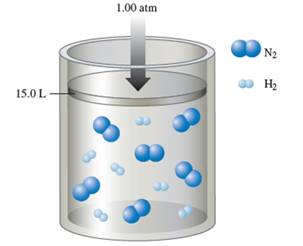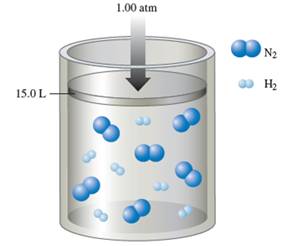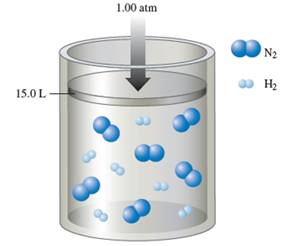
Concept explainers
(a)
Interpretation: The partial pressure of ammonia in the container needs to be determined, when the reaction is complete at constant 1.00 atm and at constant volume.

Concept Introduction: The ideal gas equation is the equation which gives the relations between P,V, n and T of gases. It can be written as:
P×V = n×R×T
Usually gases do not follow ideal behavior under all conditions of pressure, temperature and volumes. The relation of P, V, n and T of real gases can be given by Vander Waals equation:
(P + n2aV2) (V- n b) = nRT
Hence P = nRT V-nb - n2aV2
(a)
Answer to Problem 126CP
Partial pressure of NH3= 0.5 atm
Explanation of Solution
Number of H2 molecule = 6 molecules
Number of N2 gas = 6 molecules
The balance chemical equation for the formation of ammonia:
N2+ 3 H2→2 NH3
Hence 1 molecule of N2 reacts with 3 H2 molecule to form 2 molecule of NH3 .
Hence number of N2 reacts with 6 molecules of H2 :
6 molecules of H2×1 molecules of N23 molecule of H2=2 molecules of N2
Thus remaining N2 gas molecule = 6 − 2 = 4 molecules
Number of ammonia molecule formed = 2 x 2 = 4 molecules.
Total molecules at completion of reaction = 4 +4 = 16 molecules
Calculate mole fraction of ammonia:
Mole fraction of NH3=4 molecule(4+4)molecules= 0.5
Calculate partial pressure of NH3 :
Partial pressure of NH3=Ptotal× mole fractionPartial pressure of NH3= 1.0 atm × 0.5Partial pressure of NH3= 0.5 atm
(b)
Interpretation: Interpret the mole fraction of ammonia in the container when the reaction is complete at constant 1.00 atm and at constant volume.

Concept Introduction: The ideal gas equation is the equation which gives the relations between P,V, n and T of gases. It can be written as:
P×V = n×R×T
Usually gases do not follow ideal behavior under all conditions of pressure, temperature and volumes. The relation of P, V, n and T of real gases can be given by Vander Waals equation:
(P + n2aV2) (V- n b) = nRT
Hence P = nRT V-nb - n2aV2
(b)
Answer to Problem 126CP
Mole fraction of NH3= 0.5
Explanation of Solution
Number of H2 molecule = 6 molecules
Number of N2 gas = 6 molecules
The balance chemical equation for the formation of ammonia:
N2+ 3 H2→2 NH3
Hence 1 molecule of N2 reacts with 3 H2 molecule to form 2 molecule of NH3 .
Hence number of N2 reacts with 6 molecules of H2 :
6 molecules of H2×1 molecules of N23 molecule of H2=2 molecules of N2
Thus remaining N2 gas molecule = 6 − 2 = 4 molecules
Number of ammonia molecule formed = 2 x 2 = 4 molecules.
Total molecules at completion of reaction = 4 +4 = 16 molecules
Calculate mole fraction of ammonia:
Mole fraction of NH3=4 molecule(4+4)molecules= 0.5
(c)
Interpretation:Interpret the volume of the container when the reaction complete if the initial pressure is 1.0 atm and volume is 15.0 L. The partial pressure of ammonia is 0.5 atm when reaction is complete.

Concept Introduction: The ideal gas equation is the equation which gives the relations between P,V, n and T of gases. It can be written as:
P×V = n×R×T
Usually gases do not follow ideal behavior under all conditions of pressure, temperature and volumes. The relation of P, V, n and T of real gases can be given by Vander Waals equation:
(P + n2aV2) (V- n b) = nRT
Hence P = nRT V-nb - n2aV2
(c)
Answer to Problem 126CP
Volume = 10.0 L
Explanation of Solution
Initial volume is 15 L. Now, total initial moles are 2n. The final number of moles can be calculated by taking sum of moles of ammonia and moles of nitrogen.
nf=2n3+2n3=4n3 mol
At constant temperature, pressure can be calculated for an ideal gas as follows:
Vini=Vfnf
Putting the values,
15 L2n=Vf4n3Vf=10 L
Thus, the final volume is 10 L.
Want to see more full solutions like this?
Chapter 18 Solutions
EBK CHEMICAL PRINCIPLES
- Protecting Groups and Carbonyls 6) The synthesis generates allethrolone that exhibits high insect toxicity but low mammalian toxicity. They are used in pet shampoo, human lice shampoo, and industrial sprays for insects and mosquitos. Propose detailed mechanistic steps to generate the allethrolone label the different types of reagents (Grignard, acid/base protonation, acid/base deprotonation, reduction, oxidation, witting, aldol condensation, Robinson annulation, etc.) III + VI HS HS H+ CH,CH,Li III I II IV CI + P(Ph)3 V ༼ Hint: no strong base added VI S VII IX HO VIII -MgBr HgCl2,HgO HO. isomerization aqeuous solution H,SO, ༽༽༤༽༽ X MeOH Hint: enhances selectivity for reaction at the S X ☑arrow_forwardDraw the complete mechanism for the acid-catalyzed hydration of this alkene. esc 田 Explanation Check 1 888 Q A slock Add/Remove step Q F4 F5 F6 A བྲA F7 $ % 5 @ 4 2 3 & 6 87 Click and drag to start drawing a structure. © 2025 McGraw Hill LLC. All Rights Reserved. Terms of Use | Privacy Ce W E R T Y U S D LL G H IK DD 요 F8 F9 F10 F1 * ( 8 9 0 O P J K L Z X C V B N M H He commandarrow_forwardExplanation Check F1 H₂O H₂ Pd 1) MCPBA 2) H3O+ 1) Hg(OAc)2, H₂O 2) NaBH4 OH CI OH OH OH hydration halohydrin formation addition halogenation hydrogenation inhalation hydrogenation hydration ☐ halohydrin formation addition halogenation formation chelation hydrogenation halohydrin formation substitution hydration halogenation addition Ohalohydrin formation subtraction halogenation addition hydrogenation hydration F2 80 F3 σ F4 F5 F6 1 ! 2 # 3 $ 4 % 05 Q W & Å © 2025 McGraw Hill LLC. All Rights Reserved. F7 F8 ( 6 7 8 9 LU E R T Y U A F9arrow_forward
- Show the mechanism steps to obtain the lowerenergy intermediate: *see imagearrow_forwardSoap is made by the previous reaction *see image. The main difference between one soap and another soap isthe length (number of carbons) of the carboxylic acid. However, if a soap irritates your skin, they mostlikely used too much lye.Detergents have the same chemical structure as soaps except for the functional group. Detergentshave sulfate (R-SO4H) and phosphate (R-PO4H2) functional groups. Draw the above carboxylic acidcarbon chain but as the two variants of detergents. *see imagearrow_forwardWhat are the reactions or reagents used? *see imagearrow_forward
- The two pKa values of oxalic acid are 1.25 and 3.81. Why are they not the same value? Show the protontransfer as part of your explanation. *see imagearrow_forwardасть Identify all the bonds that gauche interact with C-OMe in the most stable conformation of the above compound.arrow_forwardPredict the reactants used in the formation of the following compounds using Acid-Catalyzed dehydration reactionarrow_forward
 ChemistryChemistryISBN:9781305957404Author:Steven S. Zumdahl, Susan A. Zumdahl, Donald J. DeCostePublisher:Cengage Learning
ChemistryChemistryISBN:9781305957404Author:Steven S. Zumdahl, Susan A. Zumdahl, Donald J. DeCostePublisher:Cengage Learning Chemistry: An Atoms First ApproachChemistryISBN:9781305079243Author:Steven S. Zumdahl, Susan A. ZumdahlPublisher:Cengage Learning
Chemistry: An Atoms First ApproachChemistryISBN:9781305079243Author:Steven S. Zumdahl, Susan A. ZumdahlPublisher:Cengage Learning
 Chemistry for Engineering StudentsChemistryISBN:9781337398909Author:Lawrence S. Brown, Tom HolmePublisher:Cengage Learning
Chemistry for Engineering StudentsChemistryISBN:9781337398909Author:Lawrence S. Brown, Tom HolmePublisher:Cengage Learning Chemistry by OpenStax (2015-05-04)ChemistryISBN:9781938168390Author:Klaus Theopold, Richard H Langley, Paul Flowers, William R. Robinson, Mark BlaserPublisher:OpenStax
Chemistry by OpenStax (2015-05-04)ChemistryISBN:9781938168390Author:Klaus Theopold, Richard H Langley, Paul Flowers, William R. Robinson, Mark BlaserPublisher:OpenStax Principles of Modern ChemistryChemistryISBN:9781305079113Author:David W. Oxtoby, H. Pat Gillis, Laurie J. ButlerPublisher:Cengage Learning
Principles of Modern ChemistryChemistryISBN:9781305079113Author:David W. Oxtoby, H. Pat Gillis, Laurie J. ButlerPublisher:Cengage Learning





